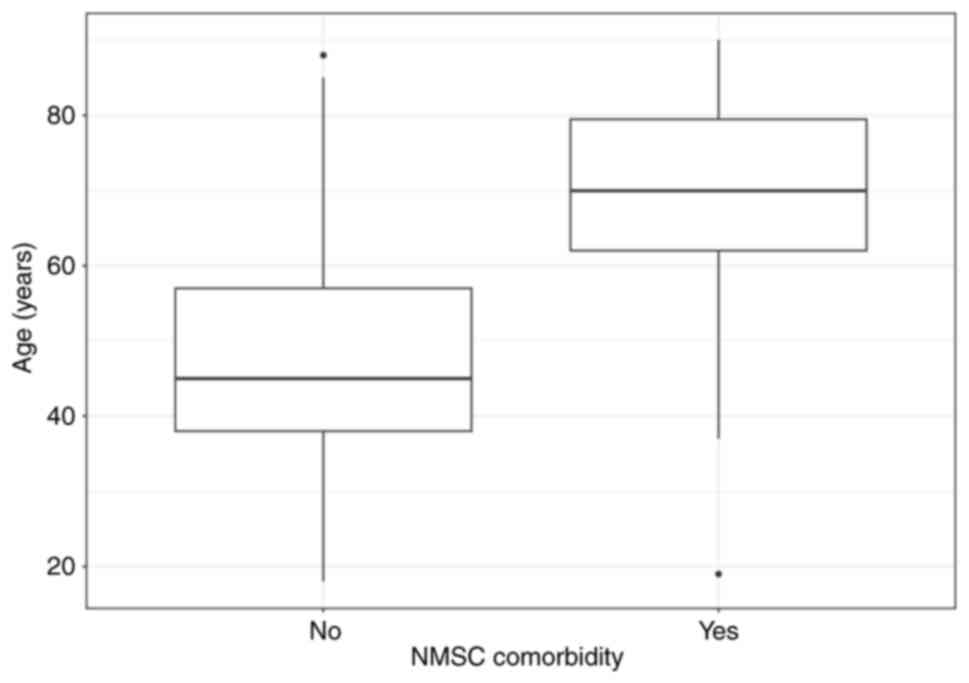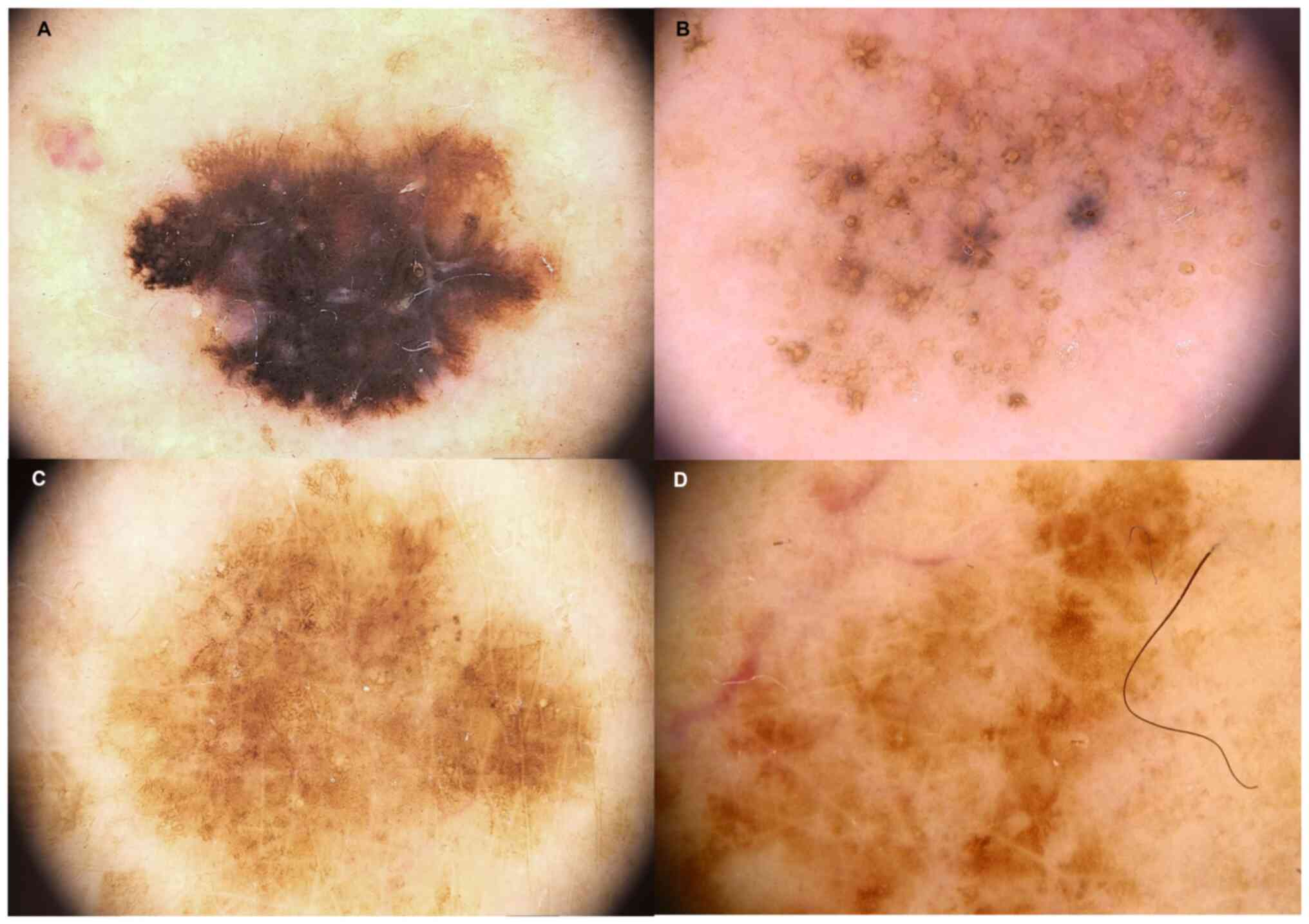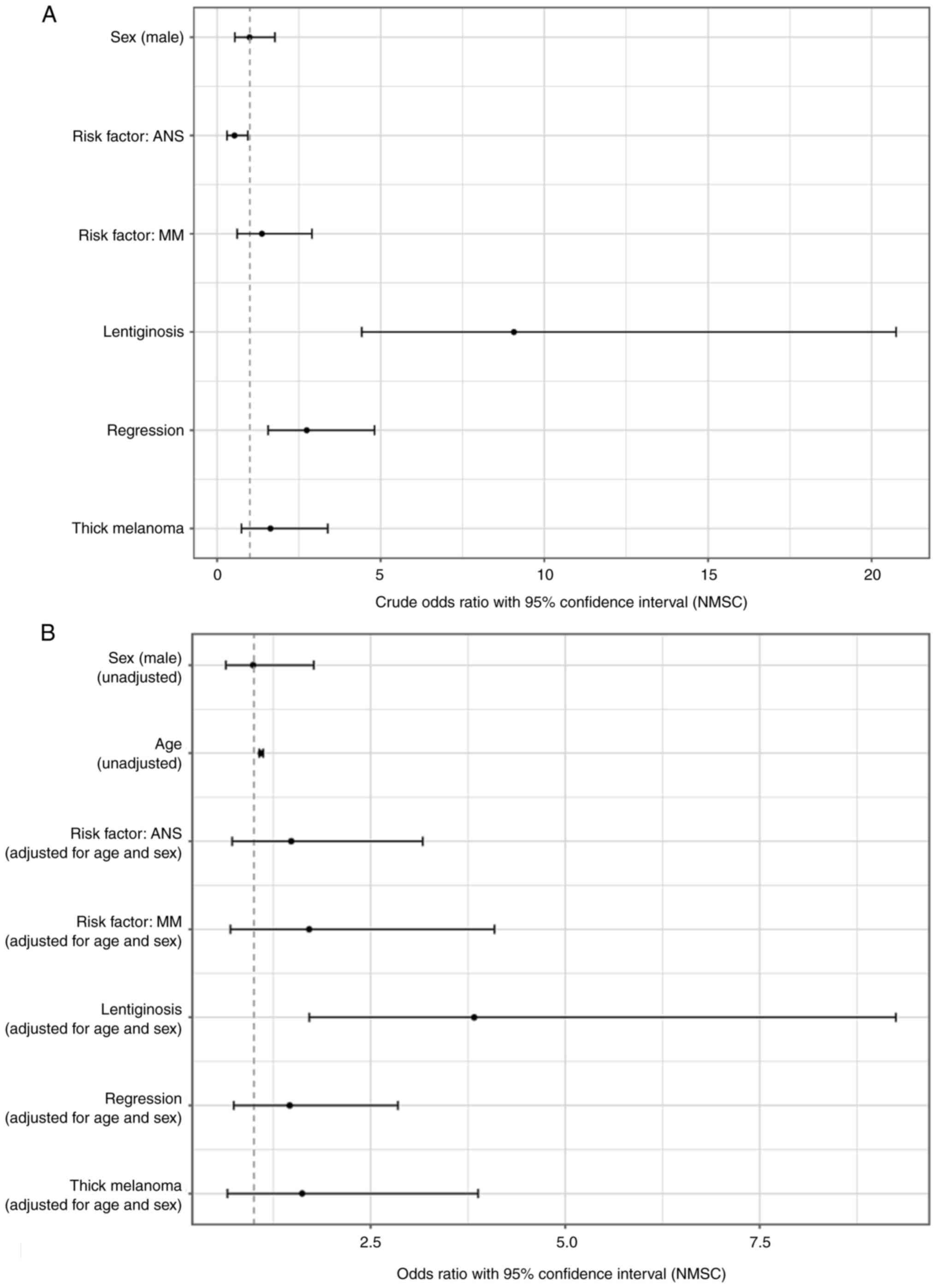|
1
|
Arnold M, Singh D, Laversanne M, Vignat J,
Vaccarella S, Meheus F, Cust AE, de Vries E, Whiteman DC and Bray
F: Global burden of cutaneous melanoma in 2020 and projections to
2040. JAMA Dermatol. 158:495–503. 2022. View Article : Google Scholar : PubMed/NCBI
|
|
2
|
Hu W, Fang L, Ni R, Zhang H and Pan G:
Changing trends in the disease burden of non-melanoma skin cancer
globally from 1990 to 2019 and its predicted level in 25 years. BMC
Cancer. 22:8362022. View Article : Google Scholar : PubMed/NCBI
|
|
3
|
Neale RE, Forman D, Murphy MF and Whiteman
DC: Site-specific occurrence of nonmelanoma skin cancers in
patients with cutaneous melanoma. Br J Cancer. 93:597–601. 2005.
View Article : Google Scholar : PubMed/NCBI
|
|
4
|
Small J, Barton V, Peterson B and Alberg
AJ: Keratinocyte carcinoma as a marker of a high cancer-risk
phenotype. Adv Cancer Res. 130:257–291. 2016. View Article : Google Scholar : PubMed/NCBI
|
|
5
|
Zocchi L, Lontano A, Merli M, Dika E,
Nagore E, Quaglino P, Puig S and Ribero S: Familial melanoma and
susceptibility genes: A review of the most common clinical and
dermoscopic phenotypic aspect, associated malignancies and
practical tips for management. J Clin Med. 10:37602021. View Article : Google Scholar : PubMed/NCBI
|
|
6
|
Toussi A, Mans N, Welborn J and Kiuru M:
Germline mutations predisposing to melanoma. J Cutan Pathol.
47:606–616. 2020. View Article : Google Scholar : PubMed/NCBI
|
|
7
|
Ciccarese G, Dalmasso B, Bruno W, Queirolo
P, Pastorino L, Andreotti V, Spagnolo F, Tanda E, Ponti G, Massone
C, et al: Clinical, pathological and dermoscopic phenotype of MITF
p.E318K carrier cutaneous melanoma patients. J Transl Med.
18:782020. View Article : Google Scholar : PubMed/NCBI
|
|
8
|
Sturm RA, Fox C, McClenahan P, Jagirdar K,
Ibarrola-Villava M, Banan P, Abbott NC, Ribas G, Gabrielli B, Duffy
DL and Soyer PH: Phenotypic characterization of nevus and tumor
patterns in MITF E318K mutation carrier melanoma patients. J Invest
Dermatol. 134:141–149. 2014. View Article : Google Scholar : PubMed/NCBI
|
|
9
|
Vergani E, Frigerio S, Dugo M, Devecchi A,
Feltrin E, De Cecco L, Vallacchi V, Cossa M, Di Guardo L, Manoukian
S, et al: Genetic variants and somatic alterations associated with
MITF-E318K germline mutation in melanoma patients. Genes (Basel).
12:14402021. View Article : Google Scholar : PubMed/NCBI
|
|
10
|
Huang JM, Chikeka I and Hornyak TJ:
Melanocytic nevi and the genetic and epigenetic control of
oncogene-induced senescence. Dermatol Clin. 35:85–93. 2017.
View Article : Google Scholar : PubMed/NCBI
|
|
11
|
Jobson D, McCormack CJ, Mar V, Tam C and
Henderson MA: Impact of chronic lymphocytic leukaemia on melanoma
outcomes: A retrospective case-control study. Br J Haematol.
197:320–325. 2022. View Article : Google Scholar : PubMed/NCBI
|
|
12
|
Olsen CM, Lane SW and Green AC: Increased
risk of melanoma in patients with chronic lymphocytic leukaemia:
Systematic review and meta-analysis of cohort studies. Melanoma
Res. 26:188–194. 2016. View Article : Google Scholar : PubMed/NCBI
|
|
13
|
Ishdorj G, Beiggi S, Nugent Z, Streu E,
Banerji V, Dhaliwal D, Mahmud SM, Marshall AJ, Gibson SB, Wiseman
MC and Johnston JB: Risk factors for skin cancer and solid tumors
in newly diagnosed patients with chronic lymphocytic leukemia and
the impact of skin surveillance on survival. Leuk Lymphoma.
60:3204–3213. 2019. View Article : Google Scholar : PubMed/NCBI
|
|
14
|
Besson C, Moore A, Wu W, Vajdic CM, de
Sanjose S, Camp NJ, Smedby KE, Shanafelt TD, Morton LM, Brewer JD,
et al: Common genetic polymorphisms contribute to the association
between chronic lymphocytic leukaemia and non-melanoma skin cancer.
Int J Epidemiol. 50:1325–1334. 2021. View Article : Google Scholar : PubMed/NCBI
|
|
15
|
Collins L, Quinn A and Stasko T: Skin
cancer and immunosuppression. Dermatol Clin. 37:83–94. 2019.
View Article : Google Scholar : PubMed/NCBI
|
|
16
|
Mittal A and Colegio OR: Skin cancers in
organ transplant recipients. Am J Transplant. 17:2509–2530. 2017.
View Article : Google Scholar : PubMed/NCBI
|
|
17
|
Rizvi SMH, Aagnes B, Holdaas H, Gude E,
Boberg KM, Bjørtuft Ø, Helsing P, Leivestad T, Møller B and
Gjersvik P: Long-term change in the risk of skin cancer after organ
transplantation: A population-based nationwide cohort study. JAMA
Dermatol. 153:1270–1277. 2017. View Article : Google Scholar : PubMed/NCBI
|
|
18
|
Omland SH, Gniadecki R, Hædersdal M,
Helweg-Larsen J and Omland LH: Skin cancer risk in hematopoietic
stem-cell transplant recipients compared with background population
and renal transplant recipients: A population-based cohort study.
JAMA Dermatol. 152:177–183. 2016. View Article : Google Scholar : PubMed/NCBI
|
|
19
|
Szlauer-Stefańska A, Kamińska-Winciorek G,
Giebel S and Bagłaj M: Secondary skin neoplasms in patients after
autologous and allogeneic hematopoietic stem cell transplantation
procedures. Adv Clin Exp Med. 29:1221–1230. 2020. View Article : Google Scholar : PubMed/NCBI
|
|
20
|
Keslova P, Formankova R, Riha P, Sramkova
L, Snajderova M, Malinova B, Luks A, Sterba J, Stary J and Sedlacek
P: Total body irradiation is a crucial risk factor for developing
secondary carcinomas after allogeneic hematopoietic stem cell
transplantation in childhood. Neoplasma. 67:1164–1169. 2020.
View Article : Google Scholar : PubMed/NCBI
|
|
21
|
Ehrhardt MJ, Brazauskas R, He W, Rizzo JD
and Shaw BE: Survival of patients who develop solid tumours
following hematopoietic stem cell transplantation. Bone Marrow
Transplant. 51:83–88. 2016. View Article : Google Scholar : PubMed/NCBI
|
|
22
|
Silverberg JI and Ratner D: Associations
of non-melanoma skin cancer and melanoma, extra-cutaneous cancers
and smoking in adults: A US population-based study. J Eur Acad
Dermatol Venereol. 29:1389–1397. 2015. View Article : Google Scholar : PubMed/NCBI
|
|
23
|
Kearney L, Hogan D, Conlon P, Roche M,
O'Neill JP and O'Sullivan JB: High-risk cutaneous malignancies and
immunosuppression: Challenges for the reconstructive surgeon in the
renal transplant population. J Plast Reconstr Aesthet Surg.
70:922–930. 2017. View Article : Google Scholar : PubMed/NCBI
|
|
24
|
Rossi M, Pellegrini C, Cardelli L,
Ciciarelli V, Di Nardo L and Fargnoli MC: Familial melanoma:
Diagnostic and management implications. Dermatol Pract Concept.
9:10–16. 2019. View Article : Google Scholar : PubMed/NCBI
|
|
25
|
Keung EZ and Gershenwald JE: The eighth
edition American Joint Committee on Cancer (AJCC) melanoma staging
system: Implications for melanoma treatment and care. Expert Rev
Anticancer Ther. 18:775–784. 2018. View Article : Google Scholar : PubMed/NCBI
|
|
26
|
Wickham H, Averick M, Bryan J, Chang W,
McGowan LDA, François R, Grolemund G, Hayes A, Henry L, Hester J,
et al: Welcome to the tidyverse. J Open Source Softw. 4:16862019.
View Article : Google Scholar
|
|
27
|
Gouda G, Pyne J and Dicker T: Pigmented
macules on the head and neck: A systematic review of dermoscopy
features. Dermatol Pract Concept. 12:e20221942022. View Article : Google Scholar : PubMed/NCBI
|
|
28
|
Carapeba MOL, Alves Pineze M and Nai GA:
Is dermoscopy a good tool for the diagnosis of lentigo maligna and
lentigo maligna melanoma? A meta-analysis. Clin Cosmet Investig
Dermatol. 12:403–414. 2019. View Article : Google Scholar : PubMed/NCBI
|
|
29
|
Moscarella E, Guitera P, Scolyer RA, Rocha
L, Thomas L, Ronchi A, Scharf C, Brancaccio G and Argenziano G:
Junctional nevus and early melanoma on sun-damaged skin of the
head/neck: A clinico-pathologic challenge. Dermatol Pract Concept.
13:e20231222023. View Article : Google Scholar : PubMed/NCBI
|
|
30
|
Praetorius C, Sturm RA and Steingrimsson
E: Sun-induced freckling: Ephelides and solar lentigines. Pigment
Cell Melanoma Res. 27:339–350. 2014. View Article : Google Scholar : PubMed/NCBI
|
|
31
|
Monestier S, Gaudy C, Gouvernet J, Richard
MA and Grob JJ: Multiple senile lentigos of the face, a skin ageing
pattern resulting from a life excess of intermittent sun exposure
in dark-skinned caucasians: A case-control study. Br J Dermatol.
154:438–444. 2006. View Article : Google Scholar : PubMed/NCBI
|
|
32
|
Bastiaens M, Hoefnagel J, Westendorp R,
Vermeer BJ and Bouwes Bavinck JN: Solar lentigines are strongly
related to sun exposure in contrast to ephelides. Pigment Cell Res.
17:225–229. 2004. View Article : Google Scholar : PubMed/NCBI
|
|
33
|
Derancourt C, Bourdon-Lanoy E, Grob JJ,
Guillaume JC, Bernard P and Bastuji-Garin S: Multiple large solar
lentigos on the upper back as clinical markers of past severe
sunburn: A case-control study. Dermatology. 214:25–31. 2007.
View Article : Google Scholar : PubMed/NCBI
|
|
34
|
Nagore E, Hueso L, Botella-Estrada R,
Alfaro-Rubio A, Serna I, Guallar J, González I, Ribes I and Guillen
C: Smoking, sun exposure, number of nevi and previous neoplasias
are risk factors for melanoma in older patients (60 years and
over). J Eur Acad Dermatol Venereol. 24:50–57. 2010. View Article : Google Scholar : PubMed/NCBI
|
|
35
|
Demierre MF: Thin melanomas and
regression, thick melanomas and older men: Prognostic implications
and perspectives on secondary prevention. Arch Dermatol.
138:678–682. 2002. View Article : Google Scholar : PubMed/NCBI
|
|
36
|
Tiodorovic-Zivkovic D, Argenziano G,
Lallas A, Thomas L, Ignjatovic A, Rabinovitz H, Moscarella E, Longo
C, Hofmann-Wellenhof R and Zalaudek I: Age, gender, and topography
influence the clinical and dermoscopic appearance of lentigo
maligna. J Am Acad Dermatol. 72:801–808. 2015. View Article : Google Scholar : PubMed/NCBI
|
|
37
|
Słowińska M, Czarnecka I, Czarnecki R,
Tatara P, Nasierowska-Guttmejer A, Lorent M, Cierniak S and
Owczarek W: Clinical, dermoscopic, and histological characteristics
of melanoma patients according to the age groups: A retrospective
observational study. Life (Basel). 13:13692023.PubMed/NCBI
|
|
38
|
Teramoto Y, Keim U, Gesierich A, Schuler
G, Fiedler E, Tüting T, Ulrich C, Wollina U, Hassel JC, Gutzmer R,
et al: Acral lentiginous melanoma: A skin cancer with unfavourable
prognostic features. A study of the German central malignant
melanoma registry (CMMR) in 2050 patients. Br J Dermatol.
178:443–451. 2018. View Article : Google Scholar : PubMed/NCBI
|
|
39
|
Keller DS, Thomay AA, Gaughan J, Olszanski
A, Wu H, Berger AC and Farma JM: Outcomes in patients with mucosal
melanomas. J Surg Oncol. 108:516–520. 2013. View Article : Google Scholar : PubMed/NCBI
|
|
40
|
Jaimes N, Marghoob AA, Rabinovitz H, Braun
RP, Cameron A, Rosendahl C, Canning G and Keir J: Clinical and
dermoscopic characteristics of melanomas on nonfacial chronically
sun-damaged skin. J Am Acad Dermatol. 72:1027–1035. 2015.
View Article : Google Scholar : PubMed/NCBI
|
|
41
|
DeWane ME, Kelsey A, Oliviero M,
Rabinovitz H and Grant-Kels JM: Melanoma on chronically sun-damaged
skin: Lentigo maligna and desmoplastic melanoma. J Am Acad
Dermatol. 81:823–833. 2019. View Article : Google Scholar : PubMed/NCBI
|
|
42
|
Massone C, Hofman-Wellenhof R, Chiodi S
and Sola S: Dermoscopic criteria, histopathological correlates and
genetic findings of thin melanoma on non-volar skin. Genes (Basel).
12:12882021. View Article : Google Scholar : PubMed/NCBI
|
|
43
|
Navarrete-Dechent C, Cordova M, Liopyris
K, Rishpon A, Aleissa S, Rossi AM, Lee E, Chen CJ, Busam KJ,
Marghoob AA and Nehal KS: Reflectance confocal microscopy and
dermoscopy aid in evaluating repigmentation within or adjacent to
lentigo maligna melanoma surgical scars. J Eur Acad Dermatol
Venereol. 34:74–81. 2020. View Article : Google Scholar : PubMed/NCBI
|
|
44
|
Licata G, Scharf C, Ronchi A, Pellerone S,
Argenziano G, Verolino P and Moscarella E: Diagnosis and management
of melanoma of the scalp: A review of the literature. Clin Cosmet
Investig Dermatol. 14:1435–1447. 2021. View Article : Google Scholar : PubMed/NCBI
|
|
45
|
Pizzichetta MA, Polesel J, Perrot JL,
Rubegni P, Fiorani D, Rizzo A, Stanganelli I, Magi S, Mazzoni L,
Medri M, et al: Amelanotic/hypomelanotic lentigo maligna:
Dermoscopic and confocal features predicting diagnosis. J Eur Acad
Dermatol Venereol. 37:303–310. 2023. View Article : Google Scholar : PubMed/NCBI
|
|
46
|
Spyridis I, Papageorgiou C, Apalla Z,
Manoli SM, Eftychidoy P, Gkentsidi T, Bobos M, Boutis A, Vakirlis
E, Sotiriou E, et al: The peculiar dermatoscopic pattern of scalp
melanoma. J Eur Acad Dermatol Venereol. 36:1564–1567. 2022.
View Article : Google Scholar : PubMed/NCBI
|
|
47
|
Slowinska M, Kaminska-Winciorek G,
Kowalska-Oledzka E, Czarnecka I, Czarnecki R, Nasierowska-Guttmejer
A, Paluchowska E and Owczarek W: Dermoscopy of small diameter
melanomas with the diagnostic feasibility of selected algorithms-A
clinical retrospective multicenter study. Cancers (Basel).
13:60952021. View Article : Google Scholar : PubMed/NCBI
|
|
48
|
Ferrari B, Pupelli G, Farnetani F, De
Carvalho NT, Longo C, Reggiani C, Argenziano G and Pellacani G:
Dermoscopic difficult lesions: An objective evaluation of
reflectance confocal microscopy impact for accurate diagnosis. J
Eur Acad Dermatol Venereol. 29:1135–1140. 2015. View Article : Google Scholar : PubMed/NCBI
|
|
49
|
Zheng J, Yu X, Jiang L, Xiao M, Bai B, Lu
J and Zhou Y: Association between the Cytotoxic T-lymphocyte
antigen 4 +49G > A polymorphism and cancer risk: A
meta-analysis. BMC Cancer. 10:5222010. View Article : Google Scholar : PubMed/NCBI
|
|
50
|
Bouwhuis MG, Gast A, Figl A, Eggermont
AMM, Hemminki K, Schadendorf D and Kumar R: Polymorphisms in the
CD28/CTLA4/ICOS genes: Role in malignant melanoma susceptibility
and prognosis? Cancer Immunol Immunother. 59:303–312. 2010.
View Article : Google Scholar : PubMed/NCBI
|
|
51
|
Welsh MM, Applebaum KM, Spencer SK, Perry
AE, Karagas MR and Nelson HH: CTLA4 variants, UV-induced tolerance,
and risk of non-melanoma skin cancer. Cancer Res. 69:6158–6163.
2009. View Article : Google Scholar : PubMed/NCBI
|















